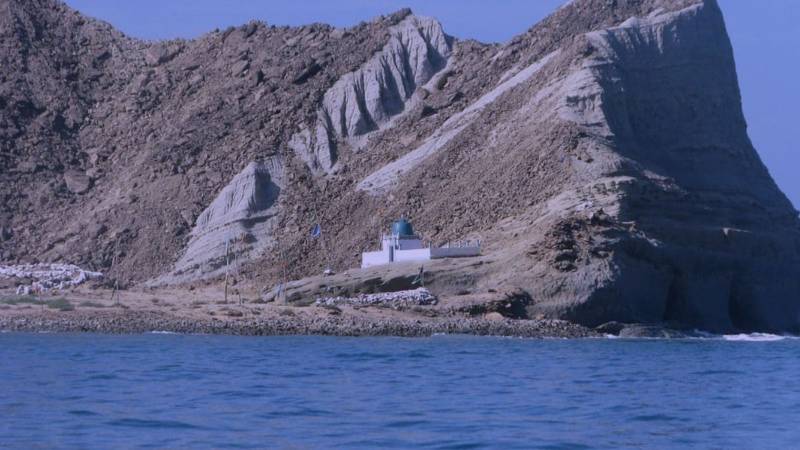
If you set off on a motorboat journey eastward from the coastal city of Pasni, in Balochistan, Pakistan, you will encounter a hidden treasure of the Arabian Sea: Astola Island. Known locally as Haft Talar, or "Seven Hills," the island rises dramatically from the sea, its seven peaks stretching up to 240 feet (73 meters) above sea level. This uninhabited island, located approximately 20 nautical miles (37 kilometers) offshore, is a paradise for nature enthusiasts, with its pristine sandy beaches, crystal-clear waters, and vibrant marine life.
Astola Island, the only offshore island in Pakistan to be declared a marine protected area, has been recognized as a Ramsar site for its ecological significance. The Balochistan government designated it as a protected area in June 2017, encompassing a vast expanse of 401.47 square kilometers, including the island’s 6.7 square kilometers and its surrounding marine buffer zone. Despite its status as a sanctuary, the island faces numerous threats to its rich biodiversity, ranging from illegal fishing practices to the impact of unregulated tourism.
The International Union for Conservation of Nature (IUCN) conducted a survey on Astola, uncovering an extraordinary variety of life. The island hosts 61 species of birds, including rare and endemic species like falcons. It is also home to seven types of reptiles, such as the saw-scaled viper, and numerous mammals, including the endangered humpback whale and the Indo-Pacific finless porpoise. Additionally, the waters around the island teem with life, harboring 27 fish species, two globally endangered sea turtle species (green turtles and hawksbill turtles), and 11 varieties of coral.
The land itself supports an array of grasses and shrubs, though the absence of freshwater prevents the growth of trees. Coral reefs around the island are crucial habitats for marine organisms, from sponges and clams to crabs and starfish. However, these reefs are under increasing pressure from human activity.
Astola’s allure extends beyond its natural beauty. The island has a rich cultural history, with remnants of a Hindu temple dedicated to Kali Devi, an ancient goddess, standing alongside a small mosque that local fishermen revere as the shrine of Khwaja Khidr, a legendary saint associated with water. These structures speak to the island’s significance to the diverse communities that have visited over centuries.
A lighthouse, constructed in 1982 and now powered by solar energy, serves as a beacon for seafarers. Stories of the island’s spiritual importance endure among fishermen, who believe Khwaja Khidr comes to their aid in times of distress at sea.
Despite its protected status, Astola’s ecosystems face numerous challenges. The unchecked activities of fishing trawlers, particularly from neighboring Sindh, are a significant threat. These trawlers deploy destructive nets that scrape the seabed clean, devastating coral colonies and disrupting the marine food chain. During the summer, migratory birds that nest along the Makran coast are also endangered by such practices.
Locals contribute unintentionally to the island’s decline. Fishermen who use the island as a temporary shelter often burn bushes for cooking fuel, damaging vegetation. In the 1960s, cats were introduced to the island to control a rat population that damaged fishing nets. These cats now pose a major threat to the nesting birds and turtles, preying on their eggs and hatchlings.
Plastic pollution and discarded fishing nets litter the island, exacerbating the situation. Social activist Nadir Shah laments, “Astola is caught in a paradox. It’s declared a reserve but is simultaneously promoted as a tourist destination. Without proper management, the island’s ecosystem is at risk of irreversible damage.”
Jurisdiction over Astola Island is divided among various entities. While it falls under the administrative boundaries of Pasni Tehsil in Gwadar District, the provincial Fisheries Department oversees activities up to 12 nautical miles from the coast. Beyond this range, the Maritime Security Agency (MSA) is responsible for enforcement. Yet, both agencies face challenges in monitoring and managing the island effectively due to resource constraints.
Dr. Hassan Ali, a marine biologist, underscores the urgency of protecting Astola’s coral reefs. “Corals are not just underwater beauty; they’re ecosystems that support countless marine species. Illegal coral mining and fishing practices threaten their survival, which in turn jeopardizes the marine life dependent on them.”
The Forest and Wildlife Department’s Deputy Conservator, Amir Dashti, highlights the lack of infrastructure. “We don’t have boats or staff stationed on the island to enforce regulations or clean up waste. Our efforts are limited to awareness campaigns urging fishermen and tourists to minimize their impact.”
In 2020, a World Wildlife Fund (WWF) team surveyed Astola’s underwater ecosystem and reported that the coral reefs were in relatively good condition. However, the team warned that continued neglect could reverse this progress. Captain Farid Khan, a seasoned fisherman, recalls, “I’ve seen fewer fish over the years. The trawlers and pollution are ruining what used to be a haven for marine life.”
Efforts to preserve Astola require collective action. Local communities, conservationists, and government agencies must collaborate to create sustainable policies. Measures such as restricting trawler access, controlling invasive species, regulating tourism, and establishing permanent monitoring stations could make a significant difference.
Astola Island is not just a local treasure but a global one. Its unique biodiversity and cultural heritage make it a place worth protecting for future generations. As the sun sets over its serene landscape, the island’s beauty reminds us of the delicate balance between nature and human activity. The question remains: will we act in time to preserve this balance?

